Business Ethics & Communication: Mayo Clinic Interview Report Analysis
VerifiedAdded on 2022/08/13
|6
|1511
|13
Report
AI Summary
This report presents an analysis of an interview with Mrs. S. Bhat, the Health Information Director at Mayo Clinic, focusing on business ethics and communication within the healthcare industry. The interview explores the importance of ethical communication, especially in a complex environment like Mayo Clinic, where numerous interactions occur between patients and a diverse staff. The report highlights the ethical challenges in health information management, including issues of privacy, confidentiality, and the impact of communication failures on patient safety. Mrs. Bhat discusses her leadership style, the importance of conflict resolution, the impact of technological advancements, and strategies for fostering effective communication within her team. The interview emphasizes the need for honesty, transparency, and teamwork to facilitate effective communication and prevent medical errors. The report concludes with the interviewer's reflections on the insights gained from the interview, emphasizing the role of ethical standards in effective leadership and communication within the healthcare setting.
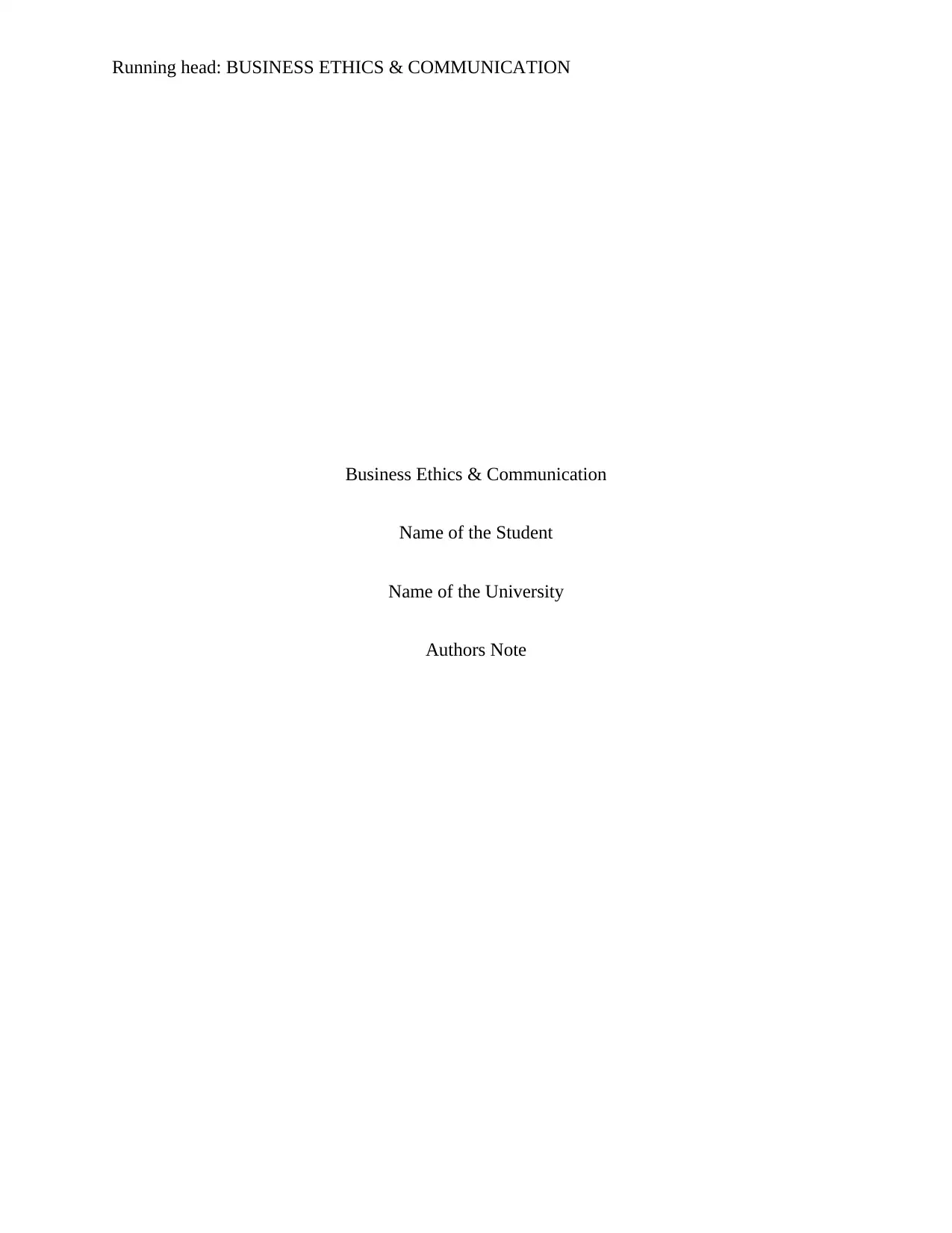
Running head: BUSINESS ETHICS & COMMUNICATION
Business Ethics & Communication
Name of the Student
Name of the University
Authors Note
Business Ethics & Communication
Name of the Student
Name of the University
Authors Note
Paraphrase This Document
Need a fresh take? Get an instant paraphrase of this document with our AI Paraphraser
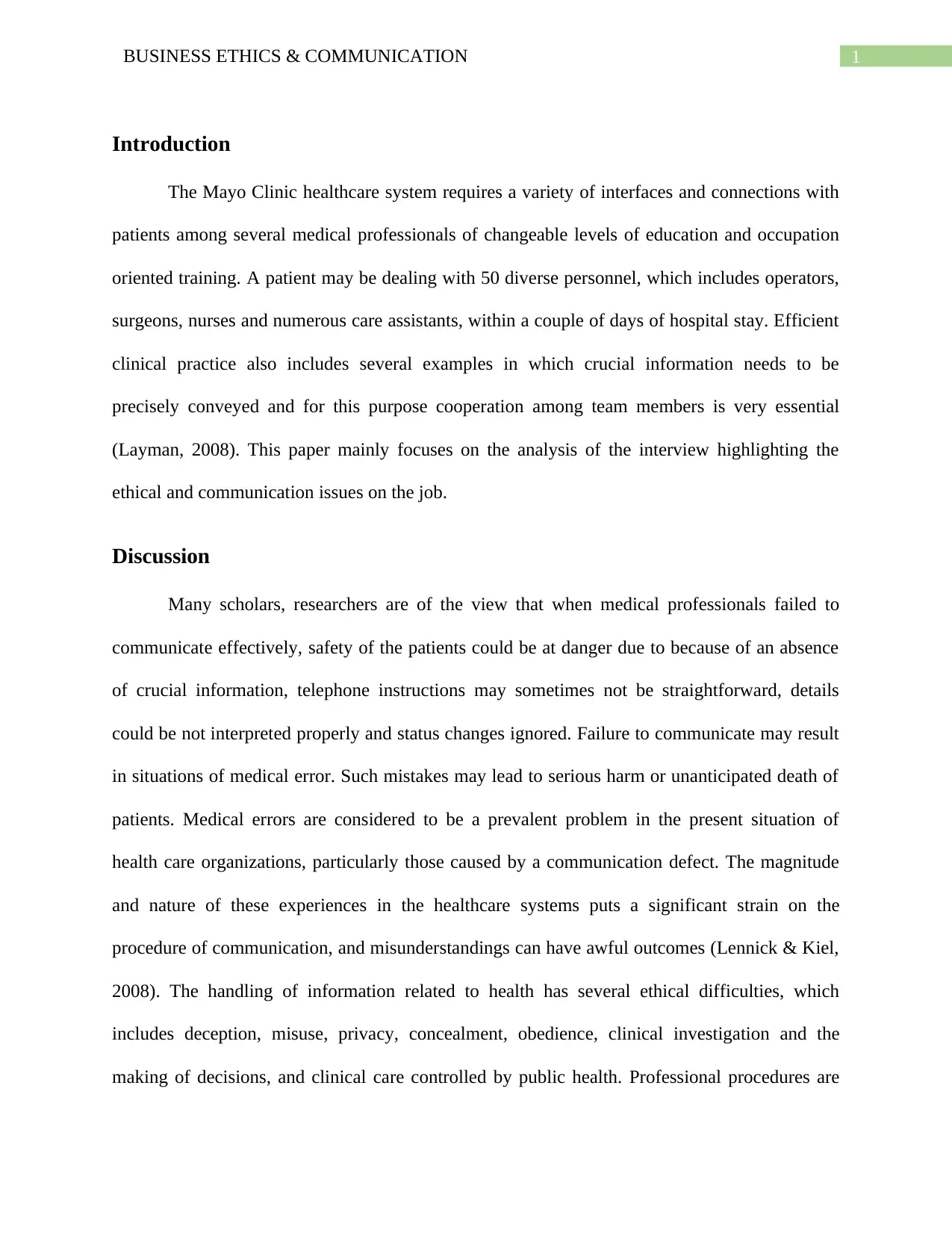
1BUSINESS ETHICS & COMMUNICATION
Introduction
The Mayo Clinic healthcare system requires a variety of interfaces and connections with
patients among several medical professionals of changeable levels of education and occupation
oriented training. A patient may be dealing with 50 diverse personnel, which includes operators,
surgeons, nurses and numerous care assistants, within a couple of days of hospital stay. Efficient
clinical practice also includes several examples in which crucial information needs to be
precisely conveyed and for this purpose cooperation among team members is very essential
(Layman, 2008). This paper mainly focuses on the analysis of the interview highlighting the
ethical and communication issues on the job.
Discussion
Many scholars, researchers are of the view that when medical professionals failed to
communicate effectively, safety of the patients could be at danger due to because of an absence
of crucial information, telephone instructions may sometimes not be straightforward, details
could be not interpreted properly and status changes ignored. Failure to communicate may result
in situations of medical error. Such mistakes may lead to serious harm or unanticipated death of
patients. Medical errors are considered to be a prevalent problem in the present situation of
health care organizations, particularly those caused by a communication defect. The magnitude
and nature of these experiences in the healthcare systems puts a significant strain on the
procedure of communication, and misunderstandings can have awful outcomes (Lennick & Kiel,
2008). The handling of information related to health has several ethical difficulties, which
includes deception, misuse, privacy, concealment, obedience, clinical investigation and the
making of decisions, and clinical care controlled by public health. Professional procedures are
Introduction
The Mayo Clinic healthcare system requires a variety of interfaces and connections with
patients among several medical professionals of changeable levels of education and occupation
oriented training. A patient may be dealing with 50 diverse personnel, which includes operators,
surgeons, nurses and numerous care assistants, within a couple of days of hospital stay. Efficient
clinical practice also includes several examples in which crucial information needs to be
precisely conveyed and for this purpose cooperation among team members is very essential
(Layman, 2008). This paper mainly focuses on the analysis of the interview highlighting the
ethical and communication issues on the job.
Discussion
Many scholars, researchers are of the view that when medical professionals failed to
communicate effectively, safety of the patients could be at danger due to because of an absence
of crucial information, telephone instructions may sometimes not be straightforward, details
could be not interpreted properly and status changes ignored. Failure to communicate may result
in situations of medical error. Such mistakes may lead to serious harm or unanticipated death of
patients. Medical errors are considered to be a prevalent problem in the present situation of
health care organizations, particularly those caused by a communication defect. The magnitude
and nature of these experiences in the healthcare systems puts a significant strain on the
procedure of communication, and misunderstandings can have awful outcomes (Lennick & Kiel,
2008). The handling of information related to health has several ethical difficulties, which
includes deception, misuse, privacy, concealment, obedience, clinical investigation and the
making of decisions, and clinical care controlled by public health. Professional procedures are
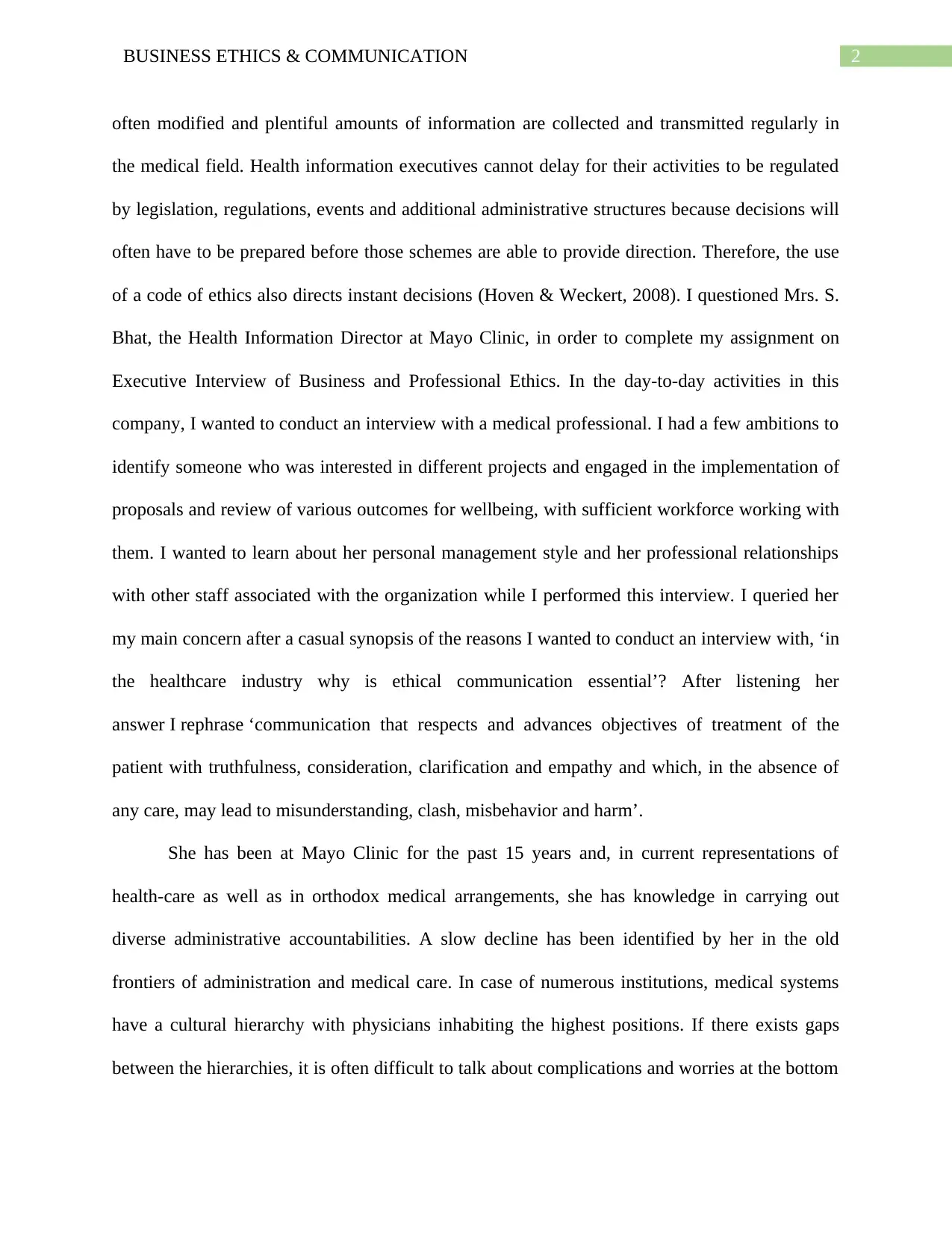
2BUSINESS ETHICS & COMMUNICATION
often modified and plentiful amounts of information are collected and transmitted regularly in
the medical field. Health information executives cannot delay for their activities to be regulated
by legislation, regulations, events and additional administrative structures because decisions will
often have to be prepared before those schemes are able to provide direction. Therefore, the use
of a code of ethics also directs instant decisions (Hoven & Weckert, 2008). I questioned Mrs. S.
Bhat, the Health Information Director at Mayo Clinic, in order to complete my assignment on
Executive Interview of Business and Professional Ethics. In the day-to-day activities in this
company, I wanted to conduct an interview with a medical professional. I had a few ambitions to
identify someone who was interested in different projects and engaged in the implementation of
proposals and review of various outcomes for wellbeing, with sufficient workforce working with
them. I wanted to learn about her personal management style and her professional relationships
with other staff associated with the organization while I performed this interview. I queried her
my main concern after a casual synopsis of the reasons I wanted to conduct an interview with, ‘in
the healthcare industry why is ethical communication essential’? After listening her
answer I rephrase ‘communication that respects and advances objectives of treatment of the
patient with truthfulness, consideration, clarification and empathy and which, in the absence of
any care, may lead to misunderstanding, clash, misbehavior and harm’.
She has been at Mayo Clinic for the past 15 years and, in current representations of
health-care as well as in orthodox medical arrangements, she has knowledge in carrying out
diverse administrative accountabilities. A slow decline has been identified by her in the old
frontiers of administration and medical care. In case of numerous institutions, medical systems
have a cultural hierarchy with physicians inhabiting the highest positions. If there exists gaps
between the hierarchies, it is often difficult to talk about complications and worries at the bottom
often modified and plentiful amounts of information are collected and transmitted regularly in
the medical field. Health information executives cannot delay for their activities to be regulated
by legislation, regulations, events and additional administrative structures because decisions will
often have to be prepared before those schemes are able to provide direction. Therefore, the use
of a code of ethics also directs instant decisions (Hoven & Weckert, 2008). I questioned Mrs. S.
Bhat, the Health Information Director at Mayo Clinic, in order to complete my assignment on
Executive Interview of Business and Professional Ethics. In the day-to-day activities in this
company, I wanted to conduct an interview with a medical professional. I had a few ambitions to
identify someone who was interested in different projects and engaged in the implementation of
proposals and review of various outcomes for wellbeing, with sufficient workforce working with
them. I wanted to learn about her personal management style and her professional relationships
with other staff associated with the organization while I performed this interview. I queried her
my main concern after a casual synopsis of the reasons I wanted to conduct an interview with, ‘in
the healthcare industry why is ethical communication essential’? After listening her
answer I rephrase ‘communication that respects and advances objectives of treatment of the
patient with truthfulness, consideration, clarification and empathy and which, in the absence of
any care, may lead to misunderstanding, clash, misbehavior and harm’.
She has been at Mayo Clinic for the past 15 years and, in current representations of
health-care as well as in orthodox medical arrangements, she has knowledge in carrying out
diverse administrative accountabilities. A slow decline has been identified by her in the old
frontiers of administration and medical care. In case of numerous institutions, medical systems
have a cultural hierarchy with physicians inhabiting the highest positions. If there exists gaps
between the hierarchies, it is often difficult to talk about complications and worries at the bottom
⊘ This is a preview!⊘
Do you want full access?
Subscribe today to unlock all pages.

Trusted by 1+ million students worldwide
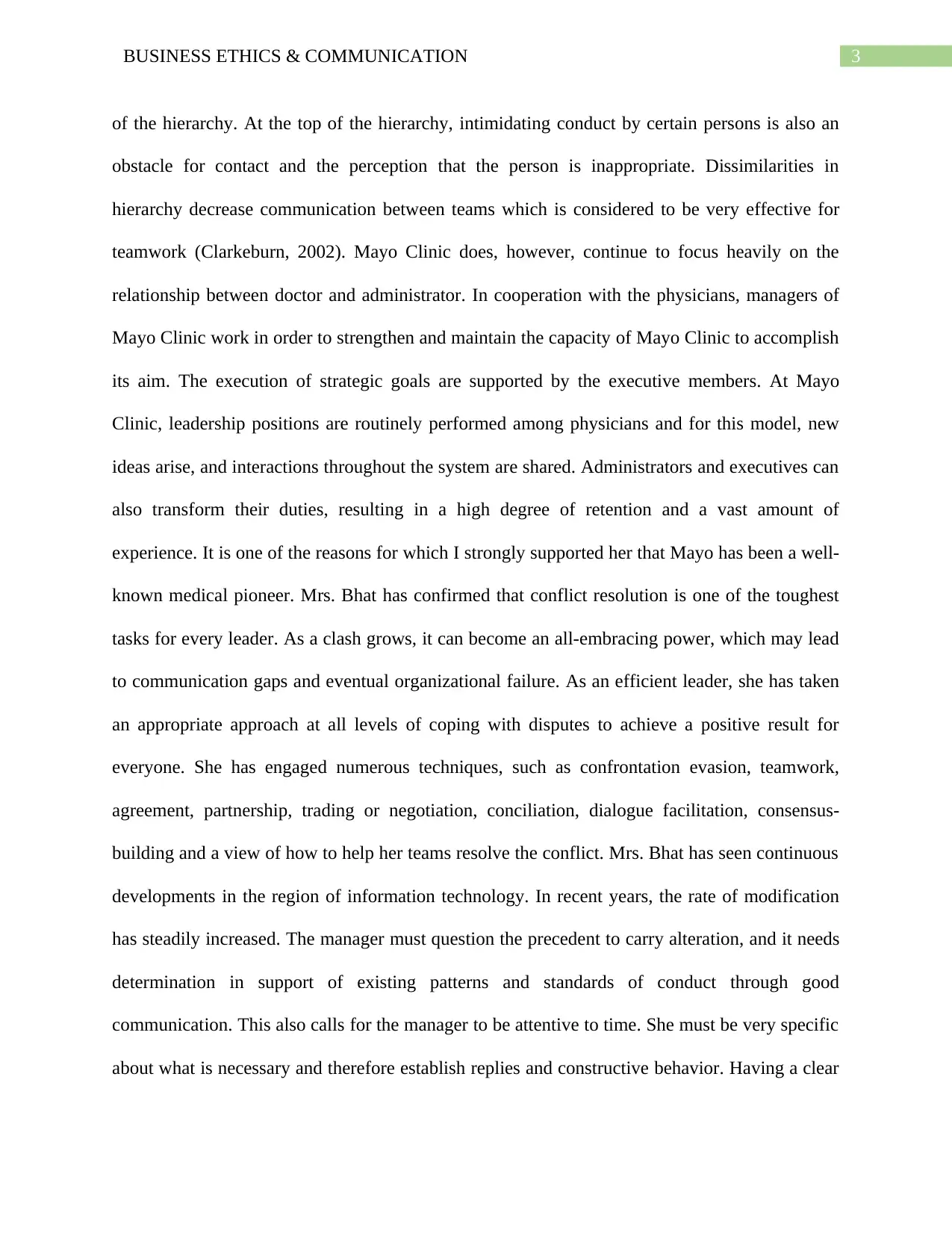
3BUSINESS ETHICS & COMMUNICATION
of the hierarchy. At the top of the hierarchy, intimidating conduct by certain persons is also an
obstacle for contact and the perception that the person is inappropriate. Dissimilarities in
hierarchy decrease communication between teams which is considered to be very effective for
teamwork (Clarkeburn, 2002). Mayo Clinic does, however, continue to focus heavily on the
relationship between doctor and administrator. In cooperation with the physicians, managers of
Mayo Clinic work in order to strengthen and maintain the capacity of Mayo Clinic to accomplish
its aim. The execution of strategic goals are supported by the executive members. At Mayo
Clinic, leadership positions are routinely performed among physicians and for this model, new
ideas arise, and interactions throughout the system are shared. Administrators and executives can
also transform their duties, resulting in a high degree of retention and a vast amount of
experience. It is one of the reasons for which I strongly supported her that Mayo has been a well-
known medical pioneer. Mrs. Bhat has confirmed that conflict resolution is one of the toughest
tasks for every leader. As a clash grows, it can become an all-embracing power, which may lead
to communication gaps and eventual organizational failure. As an efficient leader, she has taken
an appropriate approach at all levels of coping with disputes to achieve a positive result for
everyone. She has engaged numerous techniques, such as confrontation evasion, teamwork,
agreement, partnership, trading or negotiation, conciliation, dialogue facilitation, consensus-
building and a view of how to help her teams resolve the conflict. Mrs. Bhat has seen continuous
developments in the region of information technology. In recent years, the rate of modification
has steadily increased. The manager must question the precedent to carry alteration, and it needs
determination in support of existing patterns and standards of conduct through good
communication. This also calls for the manager to be attentive to time. She must be very specific
about what is necessary and therefore establish replies and constructive behavior. Having a clear
of the hierarchy. At the top of the hierarchy, intimidating conduct by certain persons is also an
obstacle for contact and the perception that the person is inappropriate. Dissimilarities in
hierarchy decrease communication between teams which is considered to be very effective for
teamwork (Clarkeburn, 2002). Mayo Clinic does, however, continue to focus heavily on the
relationship between doctor and administrator. In cooperation with the physicians, managers of
Mayo Clinic work in order to strengthen and maintain the capacity of Mayo Clinic to accomplish
its aim. The execution of strategic goals are supported by the executive members. At Mayo
Clinic, leadership positions are routinely performed among physicians and for this model, new
ideas arise, and interactions throughout the system are shared. Administrators and executives can
also transform their duties, resulting in a high degree of retention and a vast amount of
experience. It is one of the reasons for which I strongly supported her that Mayo has been a well-
known medical pioneer. Mrs. Bhat has confirmed that conflict resolution is one of the toughest
tasks for every leader. As a clash grows, it can become an all-embracing power, which may lead
to communication gaps and eventual organizational failure. As an efficient leader, she has taken
an appropriate approach at all levels of coping with disputes to achieve a positive result for
everyone. She has engaged numerous techniques, such as confrontation evasion, teamwork,
agreement, partnership, trading or negotiation, conciliation, dialogue facilitation, consensus-
building and a view of how to help her teams resolve the conflict. Mrs. Bhat has seen continuous
developments in the region of information technology. In recent years, the rate of modification
has steadily increased. The manager must question the precedent to carry alteration, and it needs
determination in support of existing patterns and standards of conduct through good
communication. This also calls for the manager to be attentive to time. She must be very specific
about what is necessary and therefore establish replies and constructive behavior. Having a clear
Paraphrase This Document
Need a fresh take? Get an instant paraphrase of this document with our AI Paraphraser
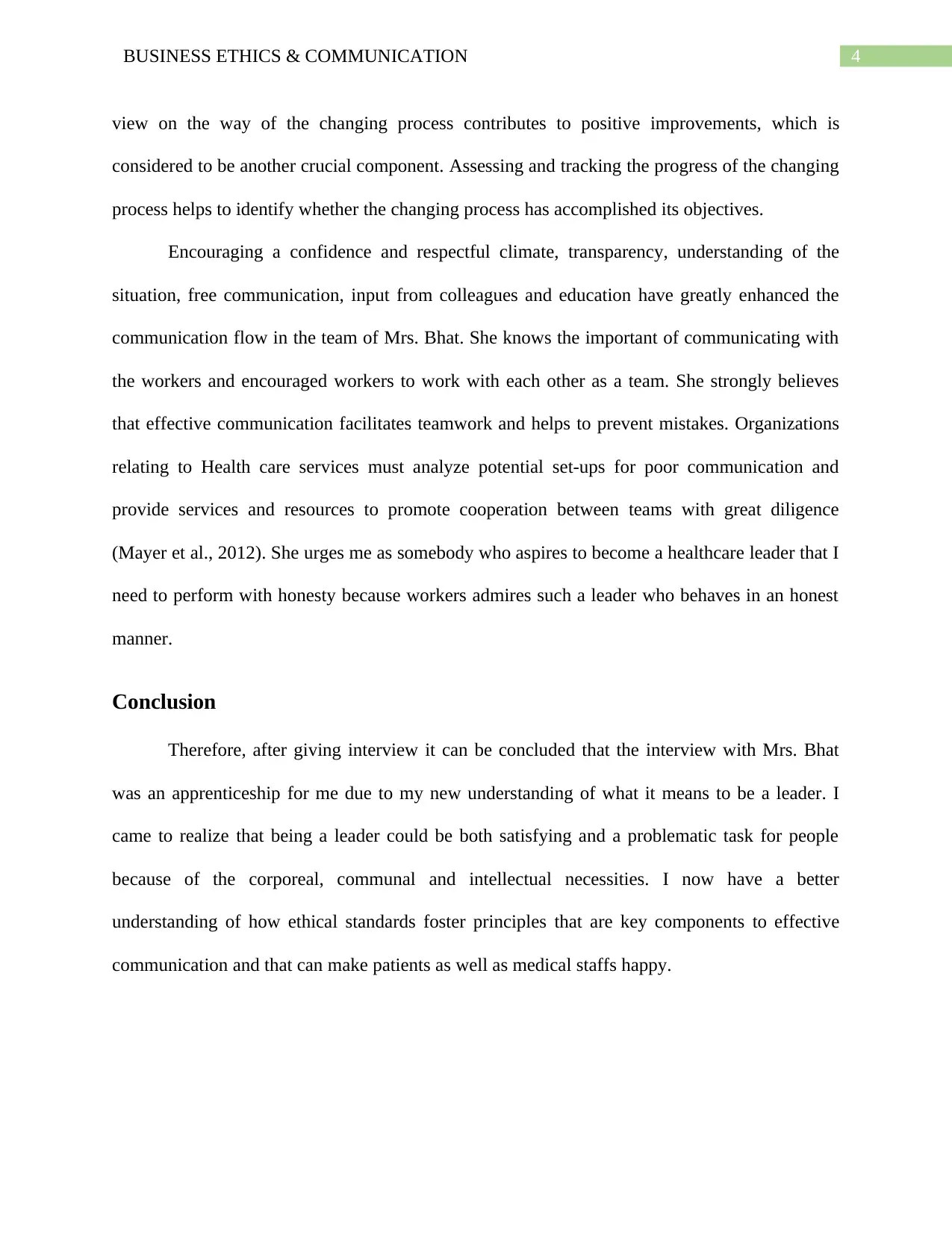
4BUSINESS ETHICS & COMMUNICATION
view on the way of the changing process contributes to positive improvements, which is
considered to be another crucial component. Assessing and tracking the progress of the changing
process helps to identify whether the changing process has accomplished its objectives.
Encouraging a confidence and respectful climate, transparency, understanding of the
situation, free communication, input from colleagues and education have greatly enhanced the
communication flow in the team of Mrs. Bhat. She knows the important of communicating with
the workers and encouraged workers to work with each other as a team. She strongly believes
that effective communication facilitates teamwork and helps to prevent mistakes. Organizations
relating to Health care services must analyze potential set-ups for poor communication and
provide services and resources to promote cooperation between teams with great diligence
(Mayer et al., 2012). She urges me as somebody who aspires to become a healthcare leader that I
need to perform with honesty because workers admires such a leader who behaves in an honest
manner.
Conclusion
Therefore, after giving interview it can be concluded that the interview with Mrs. Bhat
was an apprenticeship for me due to my new understanding of what it means to be a leader. I
came to realize that being a leader could be both satisfying and a problematic task for people
because of the corporeal, communal and intellectual necessities. I now have a better
understanding of how ethical standards foster principles that are key components to effective
communication and that can make patients as well as medical staffs happy.
view on the way of the changing process contributes to positive improvements, which is
considered to be another crucial component. Assessing and tracking the progress of the changing
process helps to identify whether the changing process has accomplished its objectives.
Encouraging a confidence and respectful climate, transparency, understanding of the
situation, free communication, input from colleagues and education have greatly enhanced the
communication flow in the team of Mrs. Bhat. She knows the important of communicating with
the workers and encouraged workers to work with each other as a team. She strongly believes
that effective communication facilitates teamwork and helps to prevent mistakes. Organizations
relating to Health care services must analyze potential set-ups for poor communication and
provide services and resources to promote cooperation between teams with great diligence
(Mayer et al., 2012). She urges me as somebody who aspires to become a healthcare leader that I
need to perform with honesty because workers admires such a leader who behaves in an honest
manner.
Conclusion
Therefore, after giving interview it can be concluded that the interview with Mrs. Bhat
was an apprenticeship for me due to my new understanding of what it means to be a leader. I
came to realize that being a leader could be both satisfying and a problematic task for people
because of the corporeal, communal and intellectual necessities. I now have a better
understanding of how ethical standards foster principles that are key components to effective
communication and that can make patients as well as medical staffs happy.
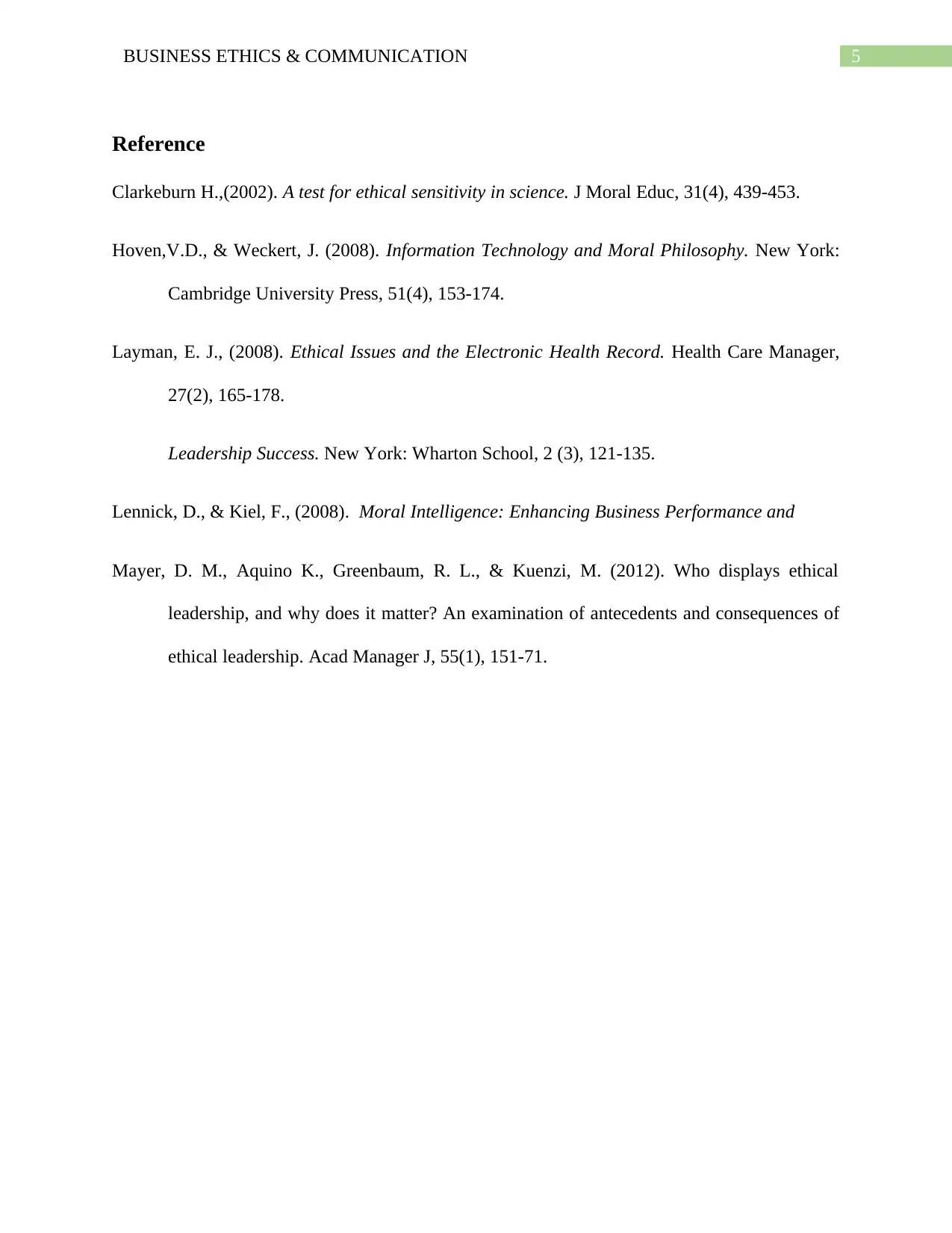
5BUSINESS ETHICS & COMMUNICATION
Reference
Clarkeburn H.,(2002). A test for ethical sensitivity in science. J Moral Educ, 31(4), 439-453.
Hoven,V.D., & Weckert, J. (2008). Information Technology and Moral Philosophy. New York:
Cambridge University Press, 51(4), 153-174.
Layman, E. J., (2008). Ethical Issues and the Electronic Health Record. Health Care Manager,
27(2), 165-178.
Leadership Success. New York: Wharton School, 2 (3), 121-135.
Lennick, D., & Kiel, F., (2008). Moral Intelligence: Enhancing Business Performance and
Mayer, D. M., Aquino K., Greenbaum, R. L., & Kuenzi, M. (2012). Who displays ethical
leadership, and why does it matter? An examination of antecedents and consequences of
ethical leadership. Acad Manager J, 55(1), 151-71.
Reference
Clarkeburn H.,(2002). A test for ethical sensitivity in science. J Moral Educ, 31(4), 439-453.
Hoven,V.D., & Weckert, J. (2008). Information Technology and Moral Philosophy. New York:
Cambridge University Press, 51(4), 153-174.
Layman, E. J., (2008). Ethical Issues and the Electronic Health Record. Health Care Manager,
27(2), 165-178.
Leadership Success. New York: Wharton School, 2 (3), 121-135.
Lennick, D., & Kiel, F., (2008). Moral Intelligence: Enhancing Business Performance and
Mayer, D. M., Aquino K., Greenbaum, R. L., & Kuenzi, M. (2012). Who displays ethical
leadership, and why does it matter? An examination of antecedents and consequences of
ethical leadership. Acad Manager J, 55(1), 151-71.
⊘ This is a preview!⊘
Do you want full access?
Subscribe today to unlock all pages.

Trusted by 1+ million students worldwide
1 out of 6
Related Documents
Your All-in-One AI-Powered Toolkit for Academic Success.
+13062052269
info@desklib.com
Available 24*7 on WhatsApp / Email
![[object Object]](/_next/static/media/star-bottom.7253800d.svg)
Unlock your academic potential
Copyright © 2020–2025 A2Z Services. All Rights Reserved. Developed and managed by ZUCOL.





